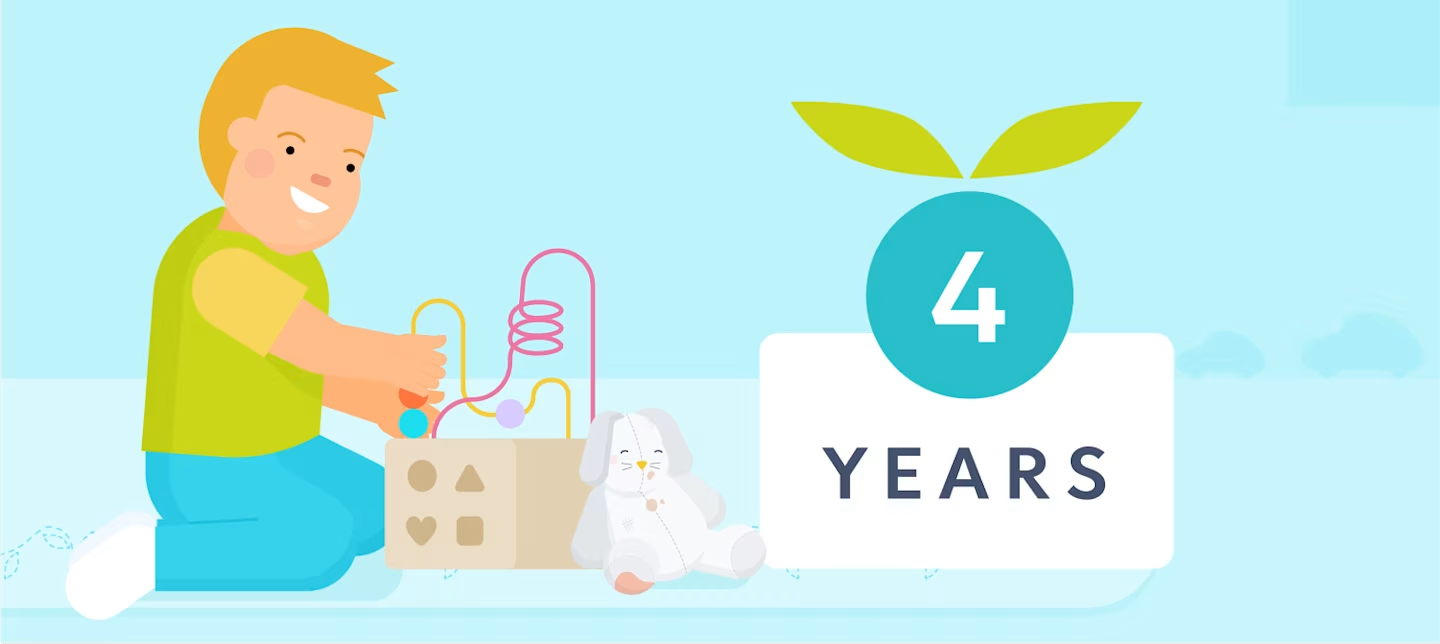4 year old sleep schedule: Bedtime and nap schedule
Updated Dec 15, 2025

At 4, your child is likely doing all sorts of like dressing themselves, helping you in the kitchen, telling stories, climbing at the playground, and more. Along with all of this growing up, they may also be getting ready to stop napping — if they haven’t done so already.
While the prospect of having an active child who doesn’t nap may sound a little daunting, we’re here to reassure you that you can create a sleep schedule that works for your 4 year old and your family. In this article, we also give you a sample schedule that accounts for 1 or 0 naps, suggest age-appropriate bedtimes, and let you know how to best avoid overtiredness as your child’s sleep needs change.
Editor's note
The recommendations listed in this article represent the average amount of sleep typically needed at 4 years old. However, keep in mind there’s a wide range of normal as some children have lower or higher sleep needs. When we discuss children and sleep at Huckleberry, we use their adjusted age (vs. actual age) which can still impact development beyond toddlerhood.
Table of Contents
How much should a 4 year old sleep?
We typically recommend aiming for about 11.5 hours of total sleep in a 24-hour period for a 4 year old, which is in line with the American Academy of Pediatrics (AAP) [] recommendation of 10 - 13 hours for 3 - 5 year olds. However, there’s a wide spectrum of normal when it comes to children and sleep and these totals should be viewed as guidelines. It’s also important to evaluate your child’s overall mood and energy levels when gauging if they’re getting enough sleep.
Here's a quick overview of what you may expect when it comes to 4 year olds and sleep. Note that these figures are averages and should be used as guidelines.
| Average total sleep | 11.5 hours |
| Number of naps | 1 |
| Goal daytime sleep | 1 - 2 hours |
| Wake windows | 6 - 6.5 hours if napping |
Top sleep tip for 4 year olds
At 4, there’s a range of normal when it comes to napping. Some children are still taking an afternoon snooze while others may have already dropped their nap. When your 4 year old doesn’t sleep during the day, consider to ensure they don’t wake up too early the next morning due to hunger. You may want to move dinner a little later or add another snack during the day so your child can comfortably sleep longer overnight without rising too early because they’re ready for breakfast. It may take some time for your 4 year old to adjust to 12 (or more!) hours between dinner and breakfast the next morning — this is normal!
Editor's note
If your child is sporadically napping or not napping at all, try offering an earlier bedtime on days they don’t sleep during the day to help avoid overtiredness. When children are overtired, it can be more difficult for them to fall asleep and stay asleep. If your preschooler is not napping at all anymore, it’s likely they’ll consistently require an earlier bedtime to allow them to sleep for around 11.5 hours overnight. Bedtime often falls between 6:30 - 7:30 PM once a kiddo is no longer taking a midday nap.
Sample 4 year old sleep schedule
| Morning rise | 6:30 AM |
| Rest time | 12:30 PM - 1:30 PM (1 hour of rest time) |
| Get ready for bed | 6:30 PM |
| Asleep | 7:00 PM |
Note: Sleep needs vary by child and this chart should be viewed as an example.
Naptime schedule for 4 years
How many naps for a 4 year old?
At 4, sleep schedules can look different from one child to the next. Often 4 year olds are from napping or have entirely. However, some preschoolers still regularly need a short nap at this age. Keep in mind that every child is different and has unique sleep requirements. There’s a wide range of normal when it comes to moving to a zero-nap schedule — some children will be ready to stop napping at 3 while others may still need a little daytime sleep until around the age of 5. According to the American Academy of Family Physicians (AAFP)[], 50% of children do not nap at age 3 and 95% of children stop napping by 5.
How long should a 4 year old nap?
If your preschooler is still napping, it’s common to see around 1 - 1.5 hours of daytime sleep. If a nap is longer than 90 minutes, this can often result in shortened nighttime sleep (less than 10 hours) and perpetuate the cycle of long naps, late bedtimes, and shortened night sleep.
If your 4 year old isn’t napping, we’ll aim for around an hour of in place of a nap. Bedtime will likely move earlier too to avoid overtiredness and so they have the opportunity for more hours of sleep at night.
1-nap schedule
| Morning rise | 6:30 AM |
| Nap | 12:30 PM - 2:00 PM (1.5 hour nap); 6 hours of being awake before nap |
| Get ready for bed | 7:45 PM |
| Asleep | 8:30 PM; 6.5 hours of being awake before bedtime |
Note: Sleep needs vary by child and this chart should be viewed as an example.
0-nap schedule
| Morning rise | 6:30 AM |
| Rest time | 12:30 PM - 1:30 PM; 1 hour of quiet time |
| Get ready for bed | 6:15 PM |
| Asleep | 7:00 PM |
Note: Sleep needs vary by child and this chart should be viewed as an example.
Do 4 year olds nap? Transitioning to rest time
If your 4 year old is transitioning away from naps or is no longer napping, we highly recommend implementing “rest time” after lunch instead. This designated quiet time can be in their bedroom (or former napping area) and can give your child time to decompress and play independently. Some days, they may surprise you and actually fall asleep! Either way, this stretch of solo time in the afternoon can be beneficial for your child — and for you too.
However, it’s not uncommon for some children to resist staying in their room alone. If this is the case, try spending 10 minutes or so of quality time in their space together before rest time — think of this time as a reimagined pre-nap routine where you’re helping them wind down and get ready for quiet time instead of sleep. Also try offering calming activities (books, toys, audiobooks, sleep stories, etc.) that are reserved only for this special rest period to make it more enticing.
Bedtime for 4 year olds
What time should a 4 year old go to bed?
Children who still nap at 4 will likely have a bedtime on the later side, often between 8:00 - 9:00 PM. This is due to preschoolers needing around 6 - 6.5 hours of awake time before sleeping, which typically results in a late bedtime following an afternoon nap. If your child starts falling asleep later than 9:00 PM on nap days, you may want to consider shortening or dropping the nap. Often a bedtime after 9:00 PM doesn’t allow for enough overnight sleep and results in overtiredness. A late bedtime can also be tricky for the rest of the family, especially if it means less downtime for you in the evenings.
Once your child has dropped the nap, bedtime will shift earlier since their awake window will go from 6 - 6.5 hours to around 12 hours without that midday sleep. This can be a big change for a child! They’ll likely be very ready for bed at an earlier time, often between 6:30 - 7:30 PM.
Why does my 4 year old keep waking up at night crying?
A 4 year old may wake during the night if they’re overtired at bedtime — something that often happens when children stop napping recently. Being overtired can actually make it harder for kids to fall and stay asleep. On the flip side, getting too much daytime sleep can also cause night wakings or early morning rising, so adjusting nap timing or duration (or phasing it out completely if they’re ready) can help rebalance their sleep.
Other reasons for new overnight waking at 4 include developmental milestones, life changes (like starting new preschool/daycare or the arrival of a sibling), illness, and travel. If you’re looking for more sleep support, consider submitting for a personalized, step-by-step Sleep Plan via .
Is there a sleep regression at 4 years old?
There’s no set date that guarantees a sleep regression at age 4. Instead, changes like starting a new preschool, feeling overtired, being sick, or experiencing nightmares can all play a role in disrupted sleep around this time.
If you’d like personalized support, we can help you create a plan tailored to your child’s needs and challenges with .
Can I sleep train a 4 year old?
Yes, you can sleep train a 4 year old! At this age, it’s more about setting clear boundaries, sticking to consistent routines, and using positive reinforcement rather than sleep training methods used for babies or toddlers. With a little patience and consistency, most preschoolers can learn to settle to sleep more independently.
What are the developmental milestones for a 4 year old?
are learning and growing so much at this age. However, not all 4 year olds will meet all of these milestones at the same time — some kiddos may be working on while others are looking towards common . This is normal! If you are concerned about your child’s growth or developmental delays when it comes to 4 - 5 year old milestones, reach out to their healthcare provider.
Stands on one foot for 10 seconds
Climbs stairs with alternating feet
Catches a ball most of the time
Hops, swings, and climbs
Draws a person with at least 3 body parts
Copies a triangle and other geometric patterns
Prints some letters
Dresses and undresses themselves
Speaks in complete sentences with 4 or more words
Uses words correctly and clearly so everyone can understand
Recalls part of their day and tells longer stories
Knows and says first and last names
Engages in more creative imaginative play with dress-up, props, etc.
Wants to be a big “helper”
Enjoys playing with other children and wants to be like them
Enjoys new experiences
Takeaway
We typically recommend aiming for about 11.5 hours of total sleep in a 24-hour period for a 4 year old. However, this may look different from child to child. At this age may be regularly napping, sometimes napping, or ditched naps altogether. There's no "right" time to end naps and it's usually based on the individual child's sleep needs and family's schedule.
If your 4 year old is transitioning out of naps or has already stopped napping, consider introducing a “rest time” after lunch. This quiet break in their bedroom (or wherever they used to nap) gives them a chance to relax and recharge, even if they don’t fall asleep. Independent play during rest time also supports creativity and self-regulation.
Once your child has dropped the nap, bedtime will shift earlier since their awake window will go from 6 - 6.5 hours to around 12 hours without that midday sleep. This can be a big change for kiddos! They’ll likely be very ready for bed at an earlier time, often between 6:30 - 7:30 PM.
If you're curious about what lies ahead when it comes to sleep, check out a . Also look back at a to see how far your child has come.
4 year old sleep FAQ
Share article:
Note: The content on this site is for informational purposes only and should not replace medical advice from your doctor, pediatrician, or medical professional. If you have questions or concerns, you should contact a medical professional.
2 Sources
Table of Contents
Share article:






